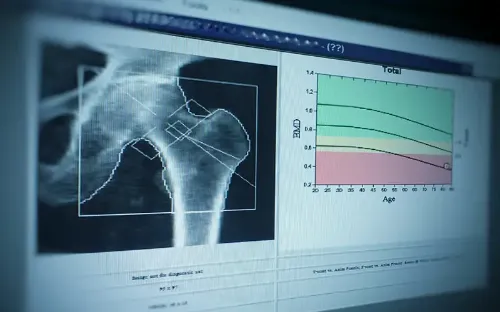Osteoporosis
"In the Clinica, the treatment of osteoporosis is individualized in each case, taking into account that the objective is to achieve greater bone strength in order to reduce the risk of fractures".
DR. JUAN CARLOS GALOFRÉ
SPECIALIST. ENDOCRINOLOGY AND NUTRITION DEPARTMENT

What is osteoporosis?
Osteoporosis is a disease characterized by a decrease in bone density due to the loss of normal bone tissue. This leads to a decrease in the resistance of the bone to trauma or stress, with the consequent occurrence of fractures.
Bone is a living tissue, in constant renewal. On the one hand, new bone is formed (bone formation), and, simultaneously, old bone is destroyed (bone resorption).
Osteoporosis appears when the balance between the two is broken, either because the formation of new bone is reduced, or because the resorption is increased, or for both reasons simultaneously.
In osteoporosis the bones become more porous, increasing the number and amplitude of the cells that exist inside them. They are thinner and more fragile and are less resistant to trauma, fracturing easily. The most frequent locations of osteoporotic fractures are: wrist, hip and vertebrae.

What are the symptoms of osteoporosis?
Osteoporosis produces no symptoms, does not hurt, and does not cause any alteration in itself. However, since the bones are very fragile, bone fractures appear very frequently, which are the ones that condition the symptoms in these patients.
The most frequent fractures in post-menopausal women's osteoporosis are vertebral fractures, which produce very sharp pain in the back and condition the progressive appearance of back deformities, basically a progressive decrease in height due to vertebral crushing. This pain can give way to a duller and more continuous pain, produced by microfractures, and which is often the symptom that leads to the diagnosis.
Osteoporosis in the elderly typically produces fractures in the long bones, above all in the wrist, and even more so in the femur, and is responsible for the typical hip fractures in the elderly.
Most common symptoms:
- Vertebral fractures.
- Microfractures.
- Pain.
- Vertebral crushing.
Do you have any of these symptoms?
You may have a problem with osteoporosis
What are the causes of osteoporosis?
Only in a small percentage of cases are the causes of osteoporosis known. They are the secondary osteoporosis, in which it appears as a consequence of another disease.
This is the case of endocrine diseases, rheumatic diseases, hematological diseases, or cases of osteoporosis related to the use of some drugs such as corticosteroids or heparin.
However, the vast majority of patients have primary osteoporosis, in which three main groups can be distinguished:
- Juvenile or adult idiopathic osteoporosis, with no known cause.
- Type I osteoporosis or post-menopausal osteoporosis, in which the lack of estrogen produced in women during this period of their lives has a decisive influence.
- Osteoporosis type II or senile, which is produced by aging.
There are also numerous factors that increase the loss of bone mass that accompanies age, and that therefore multiply the risk of suffering from osteoporosis and its consequences. Among them are the immobilization or sedentary, snuff and alcohol.
Who can be affected?
It is a disease that can affect anyone.
Over the years everyone loses bone mass, so osteoporosis is especially common after age 70.
Also women in the first years after menopause are a group especially affected by this disease.
How is osteoporosis diagnosed?

In osteoporosis there are no alterations in the basic analyses that allow the diagnosis to be made. Although the diagnosis of certainty is obtained with the study of the biopsy of the bone, in the habitual practice diverse radiological techniques are used for the diagnosis, that in addition are also useful to value the evolution of the disease and the answer to the treatment.
Simple X-rays of affected bones show osteoporosis when it is already quite advanced.
In recent years, different models of densitometers have been introduced, which are capable of measuring the density of the bone with respect to a given pattern.
Bone densitometry makes it possible to determine whether or not there is osteoporosis or osteopenia, this being a situation in which bone mineral density has begun to be lost, to predict the risk of fracture and to establish timely treatment.
How is osteoporosis treated?
We have a multidisciplinary line specialized in Osteoporosis
As general measures, a diet rich in calcium and low in protein should be followed, as well as abstention from toxins such as tobacco and alcohol, and regular physical exercise.
When diet does not guarantee adequate calcium, supplements should be given. Vitamin D administration is often associated with calcium absorption and utilization.
Drugs that decrease bone resorption are used as treatment and prevention. Estrogens, and also selective estrogen receptor modulators such as raloxifene, are used in postmenopausal osteoporosis, alone or associated with any of the above.
Recently, a parathyroid hormone analogue has been introduced in the treatment, whose action is also the stimulation of bone formation, and which is indicated in the treatment of postmenopausal osteoporosis.
Where do we treat it?
IN NAVARRA AND MADRID
The Department of Endocrinology and Nutrition of the
of the Clínica Universidad de Navarra
The Department is organized into care units with specialists totally dedicated to the study, diagnosis and treatment of this type of disease.
We work with established protocols, which ensure that all diagnostic tests to be performed are done in the shortest time possible and that the most appropriate treatment is started as soon as possible in each case.
Organized in care units
- Obesity Area.
- Diabetes Unit.
- Thyroid and Parathyroid Disease Unit.
- Osteoporosis Unit
- Other diseases: e.g. Cushing's syndrome.

Why at the Clinica?
- European Center of Excellence in the diagnosis and treatment of Obesity.
- Team of specialized nurses at the Day Hospital of Endocrinology and Nutrition.
- We have a Metabolic Research Laboratory of international prestige.



























